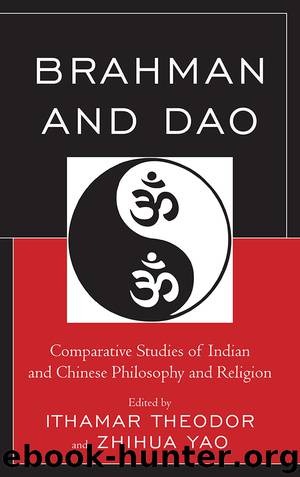Brahman and Dao by Yao Zhihua Theodor Ithamar & Zhihua Yao

Author:Yao, Zhihua,Theodor, Ithamar & Zhihua Yao [Theodor, Ithamar & Yao, Zhihua]
Language: eng
Format: epub
Publisher: Lexington Books, a division of Rowman & Littlefield Publishers, Inc.
Published: 2013-02-14T16:00:00+00:00
III
Body, Health, and Spirituality
10
Yoga and Daoyin
History, Worldview, and Techniques
Livia Kohn
Yoga, the eight-limb system associated with Patañjali’s Yogasūtras, and Daoyin, the Daoist practice of guiding (dao 導) the qi and stretching (yin 引) the body, at first glance have a lot in common. They both focus on the body as the main vehicle of attainment; they both see health and spiritual transformation as one continuum leading to perfection or self-realization; and they both work intensely and consciously with the breath. In both Yoga and Daoyin, moreover—unlike in Taiji quan and the majority of Qigong forms—physical stretches and movements are executed in all the different positions of the body, while standing, moving, sitting, and lying down. Postures are often sequenced into integrated flows and named either descriptively or after various animals.
In both systems, too, practitioners follow certain basic ethical rules and guidelines for daily living, geared to create an environment best suited to personal transformation. They learn the exact way to execute postures and movements, they gain awareness and control of their respiration, and they work to adjust the breath in accordance with the body postures. Adepts moreover use the strengthening of the muscles, loosening of the joints, and awareness of internal energies to enter into states of absorption and deeper meditation, relating actively to spiritual powers and seeking higher levels of self-realization.
Does that mean, then, that Yoga and Daoyin represent essentially the same system, just expressed in Indian and Chinese forms? Do they pursue the same goal, use the same methods, and reach similar stages, just formulated in different languages and terminologies? Is there, maybe, even a historical overlap, a mutual influence between the two systems that might explain their closeness? Or are the similarities coincidental—predicated upon the fact that all bodies move and stretch and breathe and that certain exercises are essentially good for us—and mask a deeper layer of complex and sophisticated differences in worldview, history, social role, and practice?
To answer these questions, I will look at the philosophical foundations of both practices, at historical origins and sociological settings, at their developments over time, and at the way they relate healing to spiritual realizations. I conclude with a look at their concrete practices and a general evaluation of their similarities and differences.
Philosophical Foundations
The body in Yoga forms an integral part of a body-mind continuum that cannot be separated and is seen as one. This continuum is one aspect of the material world ground, known as prakṛti. Prakṛti is real and eternal, dynamic and creative, inert and primordial (Eliade 1969, 31). It is the underlying substance of all that exists, the “noumenal matrix of creation,” “the realm of the multitudinous phenomena of contingent existence” (Feuerstein 1980, 29). It lies deep underneath the surface of natural everyday reality, representing its ultimate ground and creative potential, yet it is also the concrete, material world as it exists with all its different forms, modes, and transformations. Prakṛti at the root of all being is not accessible by ordinary sensory means
Download
This site does not store any files on its server. We only index and link to content provided by other sites. Please contact the content providers to delete copyright contents if any and email us, we'll remove relevant links or contents immediately.
| Anthropology | Archaeology |
| Philosophy | Politics & Government |
| Social Sciences | Sociology |
| Women's Studies |
The Thibaults by Roger Martin Du Gard(1524)
the god delusion by richard dawkins(1238)
The Case for God by Karen Armstrong(1157)
New Testament by Harper Bibles(978)
Not in His Image: Gnostic Vision, Sacred Ecology, and the Future of Belief by Lash John Lamb(862)
Not in His Image: Gnostic Vision, Sacred Ecology, And the Future of Belief by Lash John Lamb(848)
Spook by Mary Roach(791)
The Egyptian Book of the Dead by John Romer(776)
God Is Not Great: How Religion Poisons Everything by Christopher Hitchens(683)
Atheism For Dummies (For Dummies (Religion & Spirituality)) by McGowan Dale(664)
A History of God by Karen Armstrong(641)
Abandonment to Divine Providence by Jean-Pierre de Caussade(620)
The Imitation of Christ by Thomas à Kempis(613)
The Four Horsemen by Christopher Hitchens & Richard Dawkins & Sam Harris & Daniel Dennett(608)
The Rosicrucian Mysteries by Max Heindel(596)
Selected Writings by Thomas Aquinas(596)
Religion for Atheists by Alain de Botton(573)
The Seven Storey Mountain by Thomas Merton(570)
C. S. Lewis by James Como(569)
